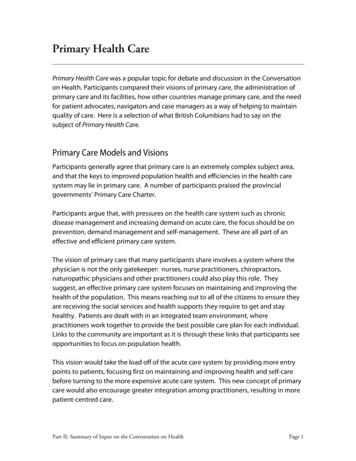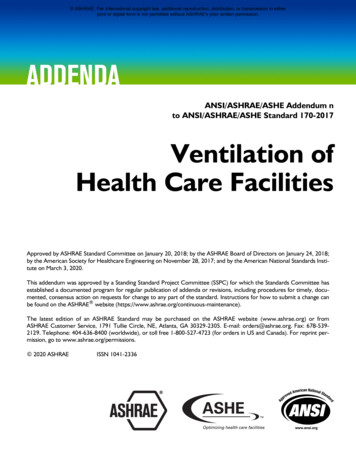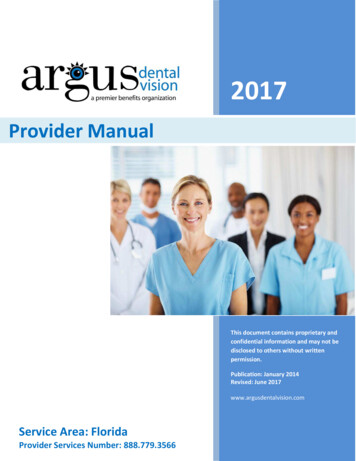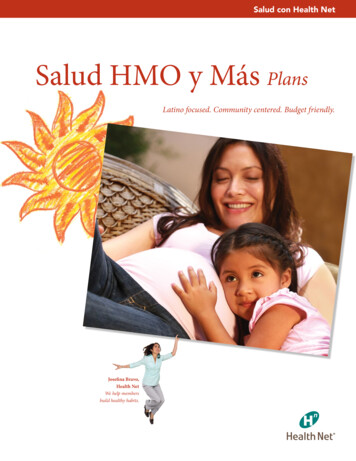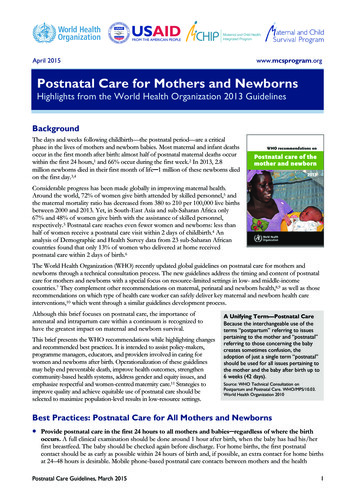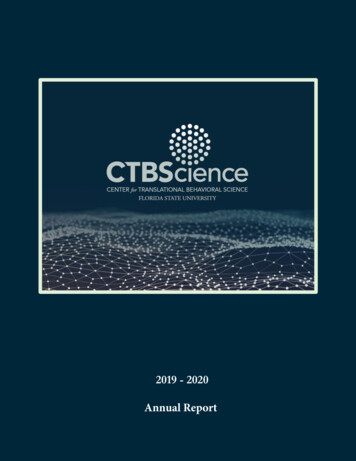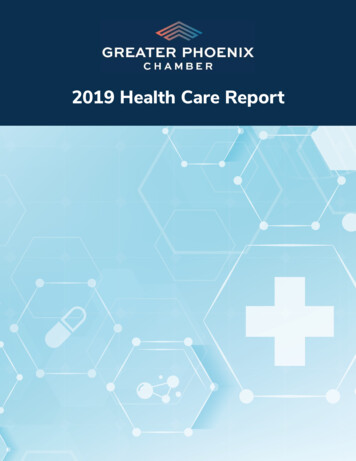
Transcription
2019 Health Care Report
Table of ContentsExecutive Summary . 1Introduction . 2Growth & Cost of Care . 3Challenges & Opportunities . 7Trends in Health Care . 9Conclusion . 12References . 13Contact Information . 14Produced by the University of Phoenixand the Greater Phoenix Chamberwith contributions from Eric Toll,Communications Manager, City of Phoenix
Executive SummaryIn an update to the Phoenix Forward HealthCare Industry Overview white paper of 2017,this report examines the current and futurestate of the health care ecosystem in theGreater Phoenix region.Arizona is the second-fastest growing statein the United States, and Phoenix is thesecond-fastest growing metro area in thecountry. The health care sector is expected tocontinue its growth in Arizona and nationally,outpacing occupations in all other sectors.By 2026, the City of Phoenix health caresector is estimated to gain 88,000 jobs, anincrease of 34% from 2016. Arizona currentlyranks 44th out of 50 states in the number ofprimary care physicians and is addressingthis shortage through legislation and funding.While progress has been made in theregistered nursing shortage, reflecting a50% improvement in staffing, the Southernand Western parts of the United Stateswill have higher shortage ratios than theNorth and Midwest. Arizona will continue toexperience increasing demand for specializednursing if strategies to address the shortagearen’t implemented.Aging populations and people with chronicconditions and comorbidities will drive muchof the expected health sector employmentgrowth in Arizona.Consumer trends include new ways of payingfor care, and industry trends show healthcare giants demonstrating a renewed focuson core business strengths and a divestingof other parts of their portfolio as spin-offs,while mergers and acquisitions continuein other parts of the sector. No longer justpharmaceutical companies, the broaderhealth care sector is marketing directlyto patients as consumers are increasinglymaking decisions about payment for careas well as timing and location of deliveryof care. Disconnects in home health arebecoming more prevalent – patients areliving longer and failing to follow up withproviders for treatment. Algorithms areneeded for population health and rural healthand opportunities exist to address ElectronicMedical Records (EMR) workflows.1
IntroductionThis white paper serves as an update to the PhoenixForward Health Care Industry Overview reportpublished by the Greater Phoenix Chamber and theUniversity of Phoenix in 2017. It provides currentdata on the health care sector in the Greater Phoenixregion as well as nationally. It features insights fromthe Arizona Chapter of the American College ofHealthcare Executives and the Arizona HealthcareExecutives, regarding desirable employee skillsets,industry trends, and untapped opportunity spaces.The Chamber considers health care a key industryfor the Greater Phoenix region. The Phoenix HealthCare Sector Partnership (PHCSP), led by the Greater2Phoenix Chamber, and the Hospital WorkforceCollaborative (HWC), organized by the GreaterPhoenix Chamber Foundation, support the growthand development of the health care sector and thoseorganizations and academic institutions who arestewards of employment and education in the GreaterPhoenix region. The PHCSP seeks to cultivate robustpartnerships that stretch across the health careecosystem in Arizona and encompasses industry andacademic organizations throughout the region, allworking to improve Arizona’s health care industry.The HWC was organized to address ongoingcritical shortages in specialized nursing withinArizona’s hospitals.
Growth & Cost of CareGrowth in the Phoenix metroarea and ArizonaIn Q1 of 2019, Arizona’s GDP grew 6.4%, makingit the second-fastest growing state in the nation.Between 2015 and 2018, the population of thePhoenix metro area grew 6%, faster than most areasacross the United States, second only to Dallas.Phoenix is expected to add approximately 108,000jobs from 2016-2026.1Within the City of Phoenix, Arizona Labor Statisticsprojects health care to grow at an annualized rate of3.4% between 2016 and 2026. This rate translatesinto an additional 88,000 health care jobs for the area,an increase of 34% over the period.2 Job growth of23% is predicted in specialized nursing inArizona alone.32016-2026 CITY OF PHOENIX OCCUPATIONAL PROJECTIONSStandard OccupationClassification (SOC)1SOCCodeSOC TitleEmployment10 Year Change10 Year Openings20162026Due to Due toDue to2Numeric PercentEstimate ProjectionGrowth Transfers Separations TotalHealth care29Practitioners0000 and 49103,01626,16734.0%26,16730,96631,57988,712Total3
Growth & Cost of CarePhoenix Metro: Employmentin Health CareTOP 25 EMPLOYERS IN MARICOPA COUNTYBanner Health26,460State of Arizona23,950Frys Food Stores14,830Phoenix Biomedical CampusWalmart14,470Nearly 20 years ago, the Phoenix CityCouncil committed to developing a 30acre Downtown city-owned site intothe Phoenix Biomedical Campus. Thatinvestment of almost 100 million hasgenerated 9,500 jobs and continues togenerate new activity to this day.Wells Fargo13,850Maricopa County13,430City of Phoenix12,060Intel Corporation10,290JPMorgan Chase Bank National Association10,070Arizona State University9,770Bank of America9,510Dignity Health9,370Honeywell8,710Mesa Unified School District 48,690United States Department of the Air Force8,050HonorHealth7,810Amazon7,570State Farm Insurance7,560McDonalds7,050United States Postal Service6,900American Express6,750Home Depot6,590Mayo Clinic6,530Safeway Stores6,352Uhaul5,760Health care companies make up four of thetop 25 employers in Maricopa County andemploy just under 50,000 people.4The vision shown in that decisionhas resulted in a strong link betweenbioscience, health care, education, andthe City of Phoenix growing strongereach year with collaboration between10 universities, medical schools, andcommunity colleges for research,development, patents, and degrees.Today, the biomedical campus is an integralcomponent of the statewide bioscienceinitiative as its faculty contributessignificantly to bioscience discoveries, thequality of health care, and the expansionand diversification of the Arizona economy.In Phoenix, the bioscience health carecollaboration means solutions rapidlymoving from discovery to delivery.By late 2021, over four million square feetof new bioscience health care facilities willbe developed in Phoenix. That numberincludes the development of primarybioscience health care facilities, medicalcenters, research and developmentlaboratories, laboratory buildings, andmedical equipment manufacturing.Health care companies4Maricopa Association of Governments. (2018). Employment Summary forMaricopa County. Retrieved August 28, 2019 from https://geo.azmag.gov/maps/azemployment/#chart
Growth & Cost of CareIt does not include the many medical office buildings,retail clinics, urgent care, rehab hospitals, long-termcare facilities, or minute-clinics that will be builtto accommodate Maricopa County and Phoenix’snation-leading population growth.In total, over 4 billion is being invested in facilitiesbeing constructed across the Greater Phoenix region.Major projects by Arizona State and Creightonuniversities, Banner Health, Mayo Clinic, andWexford Science Technology are already underconstruction to the tune of nearly one-quarter of thetotal projected capital investment. When the last ofthe proposed developments are delivered to market,there will be 7,000 new jobs to fill with an annualpayroll of almost half a billion dollars.Though bioscience health care is not the mostvisible industry sector in Phoenix, its workforce,investment, and capital facilities are majorcontributors to the Valley’s strength andglobal recognition.Health Care Sector GrowthOpportunity for employment across the healthcare sector is projected to grow 14% from 2018to 2028 nationally, more quickly than the averagefor all occupations across all other sectors, addingabout 1.9 million new jobs.5 The United StatesBureau of Labor Statistics reports that health careoccupations are projected to add more jobs than anyother occupational group.6 Projected nationally isjob growth in registered nursing of 12%,7 andin Arizona in particular, job growth of 23% 8 inspecialized nursing. This rising demand in healthcare occupations accompanies a continued increasein health care spending, which is projected togrow 5.5% through 2026, outpacing spending inother sectors.9Of the 20 fastest growing occupations,10 12 arein health care and related occupations. Increaseddemand for health care services is reflected in shiftsin economic and demographic contexts: increaseddisposable income, increasing costs for medicalgoods and services, and aging consumers’ movementfrom private health insurance to Medicare.11These occupations include: Genetic counselorsHealth specialties teachers, postsecondaryHome health aidesMedical assistantsNurse practitionersOccupational therapy assistantsPersonal care aidesPhlebotomistsPhysical therapist aidesPhysical therapist assistantsPhysician assistantsSpeech-language pathologists5
Growth & Cost of CareCost of Care in ArizonaAging populations and people with chronic conditions will drive much of the expected health care sectoremployment growth. The fastest growing among these occupations are home health aides and personal careaides. Nurse practitioners, physician assistants, and medical assistants will be in greater demand as the healthcare industry continues to move toward delivery of team-based care.While a 50% improvement in staffing has been reported in the Nurse Workforce Report Card and ShortageForecast, the Southern and Western parts of the country will experience more of a shortage than the Northand Midwest. The number of low-performing states identified in the research has improved from 18 grades of“D” and 12 grades of “F” in earlier research to 13 “Ds” and 1 “F” in this update, but the research asserts thatsupport for pipelines to improve the nursing workforce must continue.12Accompanying this employment growth comes increases in health care costs driven by the aging and chroniccare populations. Individuals age 65 are projected to make up 17.6% of the population in Maricopa Countyin 2026, compared to 19.3% for the United States.13 The projections only consider the permanent residentsin Arizona and don’t account for the high influx of winter visitors to the state, which adversely affects thepercentages shown above. An increased need for geriatric care and care for individuals with chronic diseaseand comorbidities accompanies an aging nation and creates new challenges for the health care industry.According to the Partnership to Fight Chronic Disease, in 2015, 4.2 million people in the state had at least onechronic disease, and 1.6 million had two or more. Estimates of the total cost of chronic disease in Arizona from2016-2030 sit at 1 trillion.146
Challenges & OpportunitiesKey ChallengesThe nursing workforce in Arizona, as in most states,is aging quickly, and there are no longer enoughtrained specialty nurses to meet the growingneed for their expertise. This hiring difficulty iscompounded by the ongoing challenges ofturnover among nurses at all levels of experiencein most states.to leave the profession. The number of nurses leavingthe workforce in the United States steadily grew from40,000 in 2010 to nearly 80,000 in 2020.Acute care and ambulatory care facilities arechallenged when experienced nurses retire,and novice nurse’s development is delayed andunderdeveloped without the mentoring ofexpert practicioners.According to a 2018 survey conducted by theNational Council of State Boards of Nursing and TheForum of State Nursing Workforce Centers, 50.9%of the nursing workforce is age 50 or older, and it isprojected that one million registered nurses will reachretirement age within the next 10-15 years.Arizona is expected to experience a 23% growthin demand for specialized nursing, with 20,508new openings projected by 2025. As a result ofthis demand, hospitals must hire expensive travelingnurses and pay extensive overtime in what is a verycostly support model. Recruitment for new talentcan cost up to 10,000 per nurse. Though thesenumbers vary by location and facility, when additionalThe impact of an aging nursing workforce presentscosts are incurred through orientation, education,major quality of work-life, and quality of patient careissues. The shortage of nurses increases stress on the and inactive working hours for a nurse preceptor areincluded, hospitals can spend around 170,000 oncurrent workforce which, in turn, negatively impacts15patient care quality and becomes a catalyst for nurses each new nurse they hire.Successful employees need the following skills:Real-world trainingthrough on-the-jobdevelopment orvolunteeringData-reportingand datavisualization skillsProcessimprovementexperienceCustomercentric mindsetEmpathy,openness,and agilityInsight into ahealthy work/life balanceKey OpportunitiesIn order to overcome challenges, health care employees are seeking to develop better-prepared healthcare professionals.Direct-to-consumer marketing across the sectorMobile Provider GroupsConsumers are increasingly making decisions aboutpayment for care as well as timing and locationof delivery of care. No longer just pharmaceuticalcompanies, the broader health care sector isincreasingly marketing directly to patients.Returning to the days of house calls, mobile providersare growing in number across the United States, asare group practices and clinics. Insurance companiesdo not yet contract with these groups.Other opportunities:Continuity in Home HealthPatients are living longer but failing to follow-up withproviders for treatment. Home health services aregrowing, but disconnects remain between providersand businesses about how to most effectively andseamlessly care for aging patients. Algorithms and data sharing mechanisms forpopulation healthIncreased innovation in rural healthAddress cumbersome, “glitchy” EMR workflows7
Challenges & OpportunitiesThe Greater Phoenix ChamberFoundation is strengthening healthcare talent pipelines through thehospital workforce collaborative.The health care ecosystem in the region needed amore efficient way to upskill candidates from entrylevel to specialty nursing roles, so the HospitalWorkforce Collaborative was organized by theGreater Phoenix Chamber Foundation to addressongoing critical skill shortages. The nine hospitalsinvolved in the collaborative in the Greater Phoenixregion used the Talent Pipeline Management (TPM) model to identify the greatest pain points– developing and retaining nurses in six specialtypractice areas including; OR, ICU, telemetry,300 studentsare projected tograduate throughthis new talentpipeline by 2020oncology, ER, and home health – and develop aplan to address them.The collaborative of employers established apartnership with the Maricopa CountyCommunity College District (MCCCD) to informthe curriculum of applicable nursing and healthcareprograms within the district’s ten communitycolleges to meet the needs of the growing healthcare industry.The state of Arizona approved a 5.8 millionbudget request to expand nursing programs atthe community colleges, specifically focused onupskilling existing employees. This unique approachto upskilling talent will deliver the workforce that ourlocal economy needs.936 specialty nursesare projected by major healthcare providers in the regionsto need upskilling in the nextyear across six practice areas 5.8 millionhas been committedby the state to supportcommunity collegesArizona is leading the way in addressing the health care talent shortage!Through the collaborative efforts of many stakeholders, including the Chamber’s Public Affairs team, thePhoenix Health Care Sector Partnership, and the Hospital Workforce Collaborative, Arizona has been leadingthe way in tackling our workforce challenges.State LoanRepayment ProgramMedical LicensureCompactNew SpecialtyNursing ProgramsIn 2015, Arizona expanded thestate loan repayment programfor health care professionalsto include additional highdemand occupations, such asbehavioral health.In 2016, Arizona joined the InterstateMedical Licensure Compact, whichallows reciprocity for health careprofessionals licensed to practice inother practicing states. The practicewas so successful that it wasadopted for all licenses in 2019.In collaboration with the MaricopaCounty Community CollegeDistrict, the Hospital WorkforceCollaborative is developingnew training programs toupskill experienced nurses intospecialty areas.8
Trends in Health CareHealth care facilities and educational institutionsare growing their physical footprint and expandingacross the Valley.From established health systems further saturatingtheir current markets to those groups moving to othercorners of the Valley, care providers and educationalinstitutions are increasing their reach and diversifyingtheir physical locations.New DevelopmentA minimum of 15 new health care related projects areeither in the planning stages or under constructionin Phoenix that total over 3.3 million square feet ofspace and capital investments exceeding 1.9 billion.Health Care DesignHealth care design is a collaborative effort acrossarchitects, interior designers, health care executives,health care practitioners, researchers, and others toensure that health care facilities reflect best practicesin patient care, practitioner support, environmentalsustainability, and many other aspects. Organizationslike the Center for Healthcare Design, started in1993, have been the drivers of the movement,focused on research, education, and advocacyfor patients, practitioners, and communities. Thiscollaborative effort is a growing trend toward designthat is evidence-based and focused on best practicesin health care.Among many other initiatives and projects in thehealth care sector, leaders in the health care designindustry are working to address the challenges ofthose with Alzheimer’s Disease.These projects are especially timely for Arizona.The Alzheimer’s Association estimates that, herein the United States, Arizona will have the highestprojected increase in the number of those affectedby Alzheimer’s Disease over the next decade.16 Untilrecently, there has been little attention paid to thechallenges health care environments can pose toindividuals with cognitive problems or dementia.According to AJ Thomas, American Instituteof Architects, American College of HealthcareArchitects, Evidence-Based Design Accreditation andCertification, Leadership in Energy Efficient Design,Accredited Professional, Amy Zitny, AIA, LEEDAP, and Eric Thomson, AIA, health care-focusedarchitects at Corgan Design in Phoenix, their teamwill be looking at the challenges and opportunities inhealth care facilities providing care for people withdementia. They are particularly curious about the rolethat health care design can play in creating guidelinesfor dementia care in new and existing facilities. Theproject seeks to create research-based guidelinesthat others across the country can implement toensure best practice for individuals with dementia,driven by the built environment.9
Trends in Health CareAlternative MedicineAs models for patient care continue to respond to theincreased need for new ways of providing care acrosspopulations, the mix of types of providers is changingas well. Alongside increasing numbers of nurses,physicians’ assistants, medical assistants, and otherproviders is an increase in alternative care providers,including naturopathic physicians, or NMDs/NDs.The Southwest College of Naturopathic Medicine(SCNM) in Tempe, established in 1993, is wellpositioned to answer continued shifts in thesector. According to data from the Association ofAmerican Medical Colleges (AAMC), in 2018, therewere more than 115 medical school graduatesin Arizona, a slight increase from 2017, but anoverall decrease from previous years. The State ofArizona Naturopathic Physicians Medical Boardreports continued growth in licensed NaturopathicPractitioners in the state, with 879 licensees in2017 and 1017 licensees in 2019, demonstratingan increase in alternative practice that couldserve to support existing and emerging models ofcare. According to the Association of AccreditedNaturopathic Medical Colleges (AANMC), thereare seven accredited naturopathic medical schoolsenrolling students across the United States andCanada. The 2016 AANMC alumni survey showedthat 92% of respondents are using their degree,65% have been in practice around ten years, 67%own or co-own a practice, and many practice inmultidisciplinary settings with other allopathic andalternative care providers.17 Roughly, 53% offer cashonly reimbursement, and 45% report a combinationof cash and insurance. More than half offer a slidingscale or discounts for their services.18 Naturopathicphysicians in Arizona have one of the largest10scopes of practice of alternative care providersin the country. According to Dr. Jessica Mitchell,Interim Dean, School of Naturopathic Medicine forthe Southwest College of Naturopathic Medicinein Tempe, faculty and graduates are involved innational projects like designing educational curriculafor practitioners addressing the opioid epidemicalongside allopathic and ancillary providers and arepart of conversations about the economic and socialimplications of alternative care and its potential.New Models of CareCreighton UniversityIn Fall of 2021, Creighton University Health Sciences– Phoenix Campus will become part of the growingdowntown Phoenix health care education community.Creighton’s Phoenix Campus will enroll approximately900 students and will include a four-year medicalschool, nursing school, occupational and physicaltherapy schools, pharmacy school, and physicianassistant and emergency medical services programs.Creighton’s partnership with Arizona is not new; formore than ten years, the University has been sendingmedical students to Dignity Health St. Joseph’sHospital and Medical Center for rotations. Duringthis time, more than 70% of the students placed inArizona have remained in Arizona, an importantfactor in addressing the practitioner shortage thatthe state faces.The expansion will create more than 250 jobs andproduce more than 300 million in total economicoutput, according to estimates from the GreaterPhoenix Economic Council.
Trends in Health CareDirect Primary CareDirect Primary Care (DPC) is an emerging carepayment model wherein a practitioner chargesa monthly fee that gives patients access to thepractitioner and general care services. PresidentTrump signed an executive order in June 2019urging the Secretary of the Treasury to increasetransparency around DPC and include it as a qualifiedhealth expense under IRC Section 213D. There ismuch support of this model across care providers,patients, and employers in Arizona. Industry expertscaution that potential issues with the model couldinclude lack of scalability, incentives to limit care, andincreased patient expense.19 Another item to furtherexplore is ensuring patients aren’t double paying forservices, i.e., paying for direct primary care servicesthrough their provider when their insurance alreadycovers these costs.According to the American Academy of FamilyPhysicians, DPC differs from another somewhatsimilar model, concierge medicine, in thefollowing ways:20DPC PRACTICES Monthly membership fees paid by patientsor patient’s employer Patient fees cover: extended visits,clinical, lab, consultative services, carecoordination, care management Do not accept insurance or participatein government programs, rely solely onpatient feesLarge, diversified companies focusingon strengths; emerging organizationsre-thinking modelsAt national and international levels, there are bigplayers in corners of the health care sector that arefocusing more on their strengths and divesting therest, while mergers and acquisitions continue.21In Big Pharma, GlaxoSmithKline (GSK), and Pfizerare merging their consumer businesses, and GSKwill separate what remains into two companies,consumer/vaccines, and drug discovery, followingthe merger. In devices, Medtronic, Stryker, and othersCONCIERGE PRACTICES Annual patient membership contractwith higher fees that can be paidannually or monthly Membership fees cover an in-depthphysical exam and screenings May continue to accept insuranceplans and government programs Continue to bill patients’ insurancecompany for covered services inaddition to membership fee Cater to higher-income populationsare more closely examining their portfolios. GeneralElectric (GE) recently reiterated its plan to makeGE Healthcare into its own corporation and sold itsbiopharmaceutical arm to Danaher for 21.4B.22However, when looking at those helping us tore-think our existing models, the health care sectoris becoming increasingly diverse, encompassingwhat the Institute for Healthcare Improvement’sTriple Aim23 requires: a focus on the patientexperience, health of populations, and reductionin the cost of care.11
ConclusionIn this update to the 2017 PhoenixForward Health Care Industry Overviewwhite paper, the Greater PhoenixChamber and its community partnershave again identified the health caresector as a key industry in Phoenix andthe surrounding area. With an expandingpopulation base and increasing needs forcare and the systems that support it, theChamber seeks to continue to facilitatecollaboration across academic andindustry contributors.The Greater Phoenix region hostsseveral world-class hospital systems andcontinues to grow as a top health carehub. With this sustained growth, Arizonais projected to have a nursing shortageof over 20,000 by 2025. Through theGreater Phoenix Chamber Foundation’sHospital Workforce Collaborative, theregion’s hospitals are working together toaddress the growing shortage of specialtynurses. The collaborative is testingapprenticeship opportunities and workingtoward increasing availability to upskillexisting nurses, which would allow highereducation partners to participate in thecertification of specialty nurses.The Phoenix Health Care SectorPartnership, led by the GreaterPhoenix Chamber, seeks to cultivaterobust partnerships that stretch acrossthe health ecosystem in Arizona includingorganizations and academic institutionsthat are driving change in thehealthcare sector.The City of Phoenix and its surroundingcommunities encompass big players andemerging innovators; the Chamber servesas a steward of dialogue and meaningfuldata collection and usage across thesegroups, to support the growth of thehealth sector.12
ReferencesEconomic Modeling Specialists, International. (2019). Industries by Location: Health Care and Social Assistance in AllRegions. Database accessed September 3, 2019.2Arizona Labor Statistics, Office of Economic Opportunity. (2018, August 2). 2016-2026 City of PhoenixOccupation Projections Tables. Retrieved September 3, 2019 from tainable, Scalable Upskilling in Specialty Nursing. U.S. Talent Forward: U.S. Chamber of Commerce.Retrieved from: orkforce-collaborative4Maricopa Association of Governments. (2018). Employment Summary for Maricopa County. Retrieved August 28, 2019from . Department of Labor, Bureau of Labor Statistics. (2019, September 4). Occupational Outlook Handbook,Healthcare Occupations. Retrieved September 12, 2019 from https://www.bls.gov/ooh/healthcare/home.htm6U.S. Department of Labor, Bureau of Labor Statistics. (2019, September 4). Occupational Outlook Handbook,Healthcare Occupations. Retrieved September 12, 2019 from https://www.bls.gov/ooh/healthcare/home.htm7U.S. Department of Labor, Bureau of Labor Statistics (2019, September 4). Occupational Outlook Handbook,Registered Nursing. Retrieved September 18 from es.htm8Sustainable, Scalable Upskilling in Specialty Nursing. U.S. Talent Forward: U.S. Chamber of Commerce.Retrieved from: orkforce-collaborative9CMS Office of the Actuary10U.S. Department of Labor, Bureau of Labor Statistics (2019, September 4). Occupational Outlook Handbook,Fastest Growing Occupations. Retrieved September 12 from er, G.A., Sisko, A.M., Poisal, J.A., Keehan, S.P., Smith, S.D., Madison, A.J., Wolfe, C.J., & Hardesty, J.C. (2018).National Health Expenditure Projections 2017-2026: Despite Uncertainty, Fundamentals Primarily DriveSpending Growth. Health Affairs https://doi.org/10.1377/hlthaff.2017.165512Zhang, X., Tai, D., Pforsich, H., & Lin, V.W. (2018). United States Registered Nurse Workforce Report Card andShortage Forecast: a Revisit. American Journal of Medical Quality doi: 10.1177/106286061773832813Maric
State Farm Insurance McDonalds United States Postal Service American Express Home Depot Mayo Clinic Health care companies Maricopa Association of Governments. (2018). Employment Summary for Maricopa County. Retrieved August 28, 2019 from https://geo.

